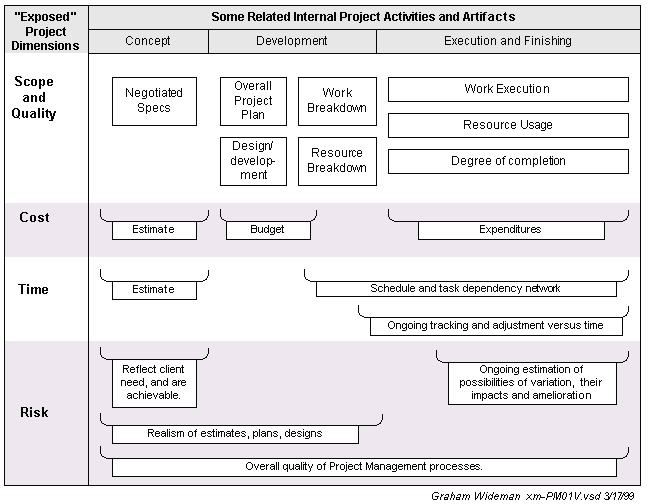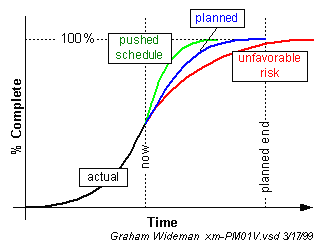Last edit: 05-03-17 Graham Wideman
| Last edit: 05-03-17 Graham Wideman |
Intelligence and Change in Enterprises |
| Project Model, Complexity Revealed Article created: 99-03-12 |
This page examines the complexities that lurk below the surface of the deceptively simple "Project Proposition", with implications for advancement through shared models.
The following diagram gives a very approximate picture of how the four "exposed" project dimensions (plus Risk) correspond to the internal features of a typical project.

Time, Task Dependencies
The "Time" parameter causes some confusion because it shows up as in issue of interest in two different ways. First, it appears as a specification for when the client and contractor agree that the project is to deliver. Second, it appears as the dimension over which the various activities and events of the project unfold, and as such may also be used as shorthand to refer to the interdependencies between tasks.
Risk
"Risk" is generally taken to refer to a two-part concept:
From that starting point, the project management function "Risk Management" elaborates on various sources of anticipatable or non-anticipatable risk scenarios, and strategies for addressing them.
Of considerable interest is that the Risk Management topic is regarded by many as complicated, fuzzy and sufficiently unglamorous that it is often either ignored or under-recognized.
Yet how credible can Project Management be in its claim to create a planned deliverable when it is applied without taking into account that things generally don't go exactly according to plan? Analyzing and addressing Risk is at the heart of Project Management taken seriously rather than superficially.
 Time and Risk Together
Time and Risk Together
This diagram shows a familiar "S-Curve" plot of a project variable as it progresses through time. In this case the plot is labeled as "% Complete", but a number of other variables progress in similar fashion (such as % expenditure, % effort and so on).
Added to this curve are examples of possible future scenarios (beyond "now"). The project may go as planned, or it may slow down due to some unfavorable risk factor, such as poor weather, or it could be sped up by activating more resources.
The point is that at any moment in the project's lifecycle, all the important variables can be examined in this way. All have a "planned" course, and all have more or less favorable courses with various degrees of probability, varying consequences and varying necessity to ameliorate those consequences.
This all adds up (multiplies?) to a very much more complex picture of project dynamics than is portrayed by focusing only on the four most obvious "exposed" parameters.
 Client versus Project Views of Project Dimensions
Client versus Project Views of Project DimensionsLoosely speaking, we can imagine that the Client Enterprise and the Project Organization each have their own set of implications in connection with the exposed project parameters, as sketched here.
Presumably, at a project's inception, the agreed-upon balance between the parameters was advantageous to both parties.
However, to leave the picture there vastly oversimplifies reality. Either party may experience situations that will disturb the balance in the parameters as originally planned. A typical example may be the project organization experiencing a strike or supply shortage, delaying the schedule. Or the sponsoring enterprise may experience a business downturn, jeopardizing payments to the project organization. Scope, Quality, Cost or Time may be impacted in certain or uncertain ways , or to put it another way, Risk will be transmitted (seen or unseen) from one party to the other.
At this point it should be noted that each organization will have completely different priorities amongst the five factors. How one organization most prefers to trade off the parameters is unlikely to be optimal for the other. The Project Organization might choose to slip the schedule, with hopes of catching up later, and worst case paying a penalty, while the Client might have become much more interested in increasing the certainty of the delivery date, and would be willing to pay more to achieve that. Or in a scenario with an internal project group, given the chance, senior management might choose one course of remedial action, but company reward structures favor project team leadership covering up problems until they are catastrophic.
Next: Current Issues for Enterprise and Project Management